Spitsbergen, also known as Svalbard, is a group of islands located in the Arctic Ocean. It is a unique and remote environment, home to various bird species.
These birds have adapted to the extreme conditions of the Arctic and have developed various strategies to survive in this harsh environment. Spitsbergen is a bird-watcher’s paradise, from the iconic Arctic Tern to the elusive Snow Bunting.
In this article, we will explore the fascinating world of birds in Spitsbergen, including their behavior, natural history, and conservation efforts to protect these incredible Arctic avian species.
20 Birds That Live In Spitsbergen
Spitsbergen, also known as Svalbard, is a group of islands located in the Arctic Ocean. It is a unique and remote environment, home to various bird species.
These birds have adapted to the extreme conditions of the Arctic and have developed various strategies to survive in this harsh environment. Spitsbergen is a bird-watcher’s paradise, from the iconic Arctic Tern to the elusive Snow Bunting.
We will explore the fascinating world of birds in Spitsbergen, including their behavior, natural history, and conservation efforts to protect these incredible Arctic avian species.
Here are 20 birds that can be found in Spitsbergen
1. Great Skua
The Great Skua is a large sea bird belonging to the family Stercorariidae, found in areas such as the Faroe Islands and Iceland.
It has a size similar to that of herring gulls, with its diet consisting mainly of fish caught at the surface or taken from other birds.
This species was first described by Danish zoologist Morten Thrane Brünnich in 1764 under the name Cath.
They are powerful predators who sometimes use mobbing tactics against larger prey like gannets and eiders until they give up their catch.
These birds mate for life but may build nests near colonies if there aren’t enough suitable territories on their island range.
Although these skuas might seem intimidating due to their fierce nature when protecting young, they can be quite timid around humans, so they should not be approached too closely.
Scientific classification:
| Kingdom | Animalia |
| Phylum | Chordata |
| Class | Aves |
| Order | Charadriiformes |
| Family | Stercorariidae |
| Genus | Stercorarius |
| Species | S. skua |
Also Featured In: Beautiful Brazilian Birds, Most Common Scotland Birds
2. Common Ringed Plover
The Common Ringed Plover is a small migratory bird found in Arctic Eurasia. It has yellowish feathers and its Latin name, Charadrius hiaticula, means ‘bird of ravines’.
This species breeds on beaches and tundra during the northern summer months before flying south when winter arrives.
Its diet consists mostly of insects it catches by running along the shoreline or through shallow water with open wings to create a shadow that helps catch prey.
The common ringed plover nests in short grasses near the water’s edge, where they lay two eggs per clutch, which hatch within three weeks.
These birds are highly territorial, so they will often defend their patch fiercely against competitors.
Scientific classification:
| Kingdom | Animalia |
| Phylum | Chordata |
| Class | Aves |
| Order | Charadriiformes |
| Family | Charadriidae |
| Genus | Charadrius |
| Species | C. hiaticula |
Also Featured In: Egyptian Birds, Shetland Islands Birds You Should Know
3. Barnacle Goose
The Barnacle Goose is a species of black goose from the Branta genus. It has mostly black plumage and can be distinguished from other types of geese, such as grey Anser species, by its unique coloring.
This bird was first classified taxonomically in 1758, and genetic studies have recently revealed that it is related to the Cackling Goose lineage rather than brant geese, to which it bears resemblance.
The barnacle goose lives all around northern Europe during the winter months. Still, she travels further north into Greenland or Svalbard for breeding season when they lay eggs on cliffs close to water sources so their young ones can easily take advantage of food-rich waters below them after hatching.
Scientific classification:
| Kingdom | Animalia |
| Phylum | Chordata |
| Class | Aves |
| Order | Anseriformes |
| Family | Anatidae |
| Genus | Branta |
| Species | B. leucopsis |
Also Featured In: Birds of United Kingdom, Flight Birds You Should Know
4. Parasitic Jaeger
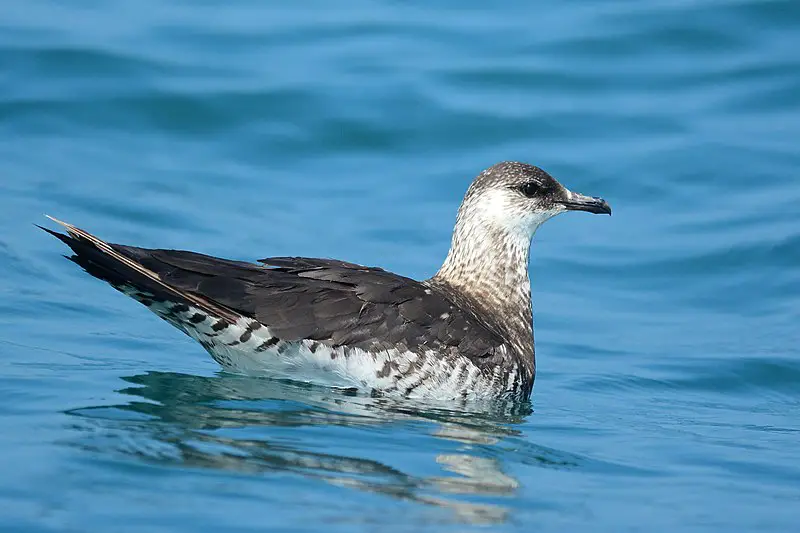
The Parasitic Jaeger is a migratory bird that breeds in cold climates of Northern Scandinavia, Scotland, Iceland, Greenland, and parts of Canada, Alaska, and Siberia.
During the breeding season, it feeds primarily on kleptoparasitism – stealing food from other birds.
In winter, they migrate to warmer regions across the southern hemisphere, where they feed mainly by scavenging off fish or carrion left behind by fishing boats or whales.
This species is easily identified by its brownish-gray plumage with white patches on its wings and tail feathers and yellow eyes, which are quite distinctive among skuas.
The parasitic jaeger has adapted to many habitats ranging from coastal areas to inland lakes, making them an interesting species to watch out for while exploring nature.
Scientific classification:
| Kingdom | Animalia |
| Phylum | Chordata |
| Class | Aves |
| Order | Charadriiformes |
| Family | Stercorariidae |
| Genus | Stercorarius |
| Species | S. parasiticus |
Also Featured In: Birds that Live in Faroe Islands, Common Birds of Portugal
5. Black Guillemot
The Black Guillemot is a striking seabird throughout the northern Atlantic and eastern North American coasts. It has black feathers, white underparts, a red bill, and bright yellow feet.
They live in single or small groups around rocky shores, cliffs, and islands.
During winter months, they migrate southwards from their high arctic breeding grounds to search for food sources such as fish eggs or invertebrates like shrimp that can be caught near shorelines.
Their diet also includes seeds and berries during the summertime while nesting on coastal ledges, creating burrows where they lay up to four pastel-colored eggs at once.
These amazing birds are very efficient swimmers, using their wings and webbed feet to propel themselves through water quickly while hunting prey.
Scientific classification:
| Kingdom | Animalia |
| Phylum | Chordata |
| Class | Aves |
| Order | Charadriiformes |
| Family | Alcidae |
| Genus | Cepphus |
| Species | C. grylle |
Also Featured In: Birds of Orkney, Acadia National Park Birds
6. Red-Throated Loon
The Red-throated Loon is a migratory bird found in the northern hemisphere, with its breeding grounds primarily located in Arctic regions and wintering spots near coastal waters.
With an average length of 55 – 67 cm (22 – 26 inches), it’s the smallest loon or diver family member.
Its name comes from its bright red throat patch, which contrasts against its white underside and grey back.
This species has adapted to life on icy seas; they are strong swimmers with powerful wings for long flights over open water when migrating seasonally.
Their diet consists mostly of fish but can also include crustaceans, molluscs, amphibians and insects depending on availability.
Scientific classification:
| Kingdom | Animalia |
| Phylum | Chordata |
| Class | Aves |
| Order | Gaviiformes |
| Family | Gaviidae |
| Genus | Gavia |
| Species | G. stellata |
Also Featured In: Native South Korean Birds, Turkey Birds You Should Know
7. Atlantic Puffin
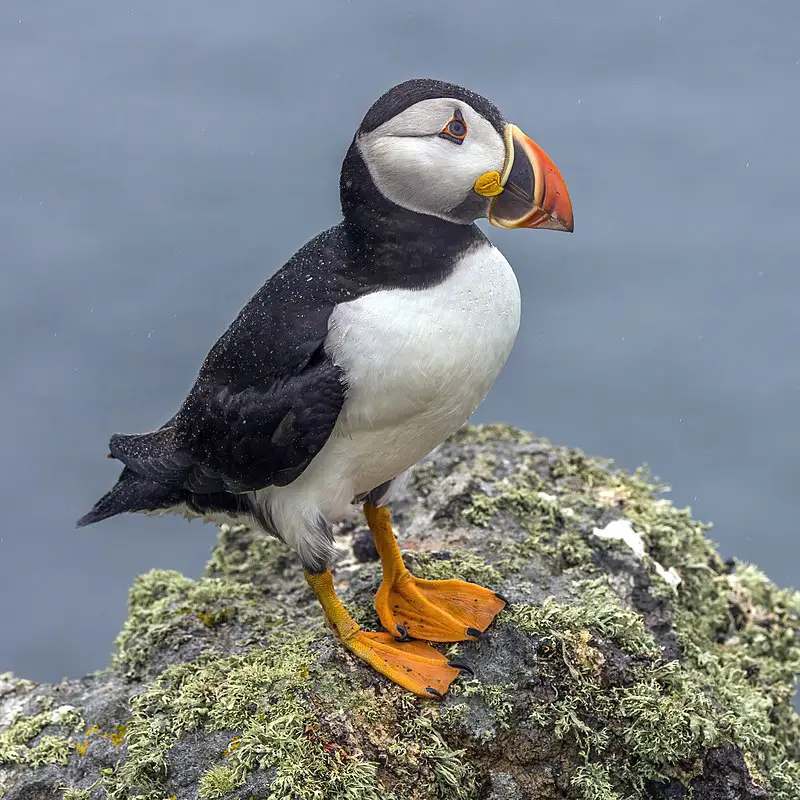
The Atlantic puffin is a seabird that belongs to the auk family. It has two related species found in the northeastern Pacific: tufted and horned puffins.
This bird breeds widely throughout Russia, Iceland, Ireland, Norway, Greenland, Canada’s Newfoundland & Labrador, and the Nova Scotia regions of the Faroe Islands.
Its colorful beak with yellowish-orange markings during mating season makes it stand out among other birds.
An interesting fact about this sea-dweller is its ability to fly underwater; it uses its wings for propulsion while swimming.
The Atlantic puffin diet consists mainly of fish caught from shallow waters near shorelines or cliffsides, They nest annually during springtime before embarking on long migrations southward towards winter grounds at seaside coasts until spring returns again.
Scientific classification:
| Kingdom | Animalia |
| Phylum | Chordata |
| Class | Aves |
| Order | Charadriiformes |
| Family | Alcidae |
| Genus | Fratercula |
| Species | F. arctica |
Also Featured In: Common Birds in Canada, Birds that Live in the Ocean
8. Purple Sandpiper
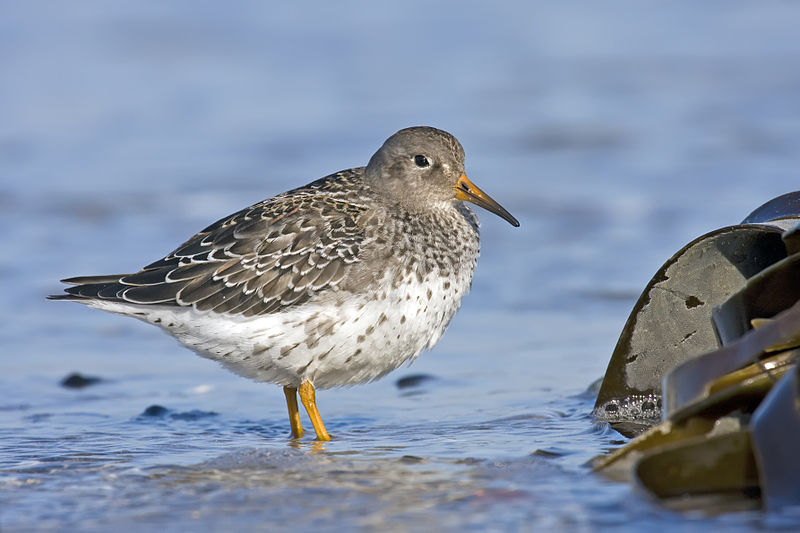
The Purple Sandpiper is a small shorebird of the Scolopacidae family, found in arctic and subarctic regions of Eurasia and North America. In winter, it migrates south to the Atlantic coast for warmer temperatures.
It was formally described by Danish zoologist Morten Thrane Brünnich back in 1764 as Tringa maratina.
Generally grayish-brown with purple highlights on its head, neck, and wings when seen from afar, this bird has white underparts contrasting beautifully against its darker feathers while standing out prominently against snow or ice-covered landscapes during winters.
Its diet consists mainly of insects but also includes seeds, worms, and other invertebrates, which they search for along rocky shores or mudflats near ocean coasts.
Scientific classification:
| Kingdom | Animalia |
| Phylum | Chordata |
| Class | Aves |
| Order | Charadriiformes |
| Family | Scolopacidae |
| Genus | Calidris |
| Species | C. maritima |
Also Featured In: Birds of Netherlands, Autumn Birds You Should Know
9. Black-Legged Kittiwake
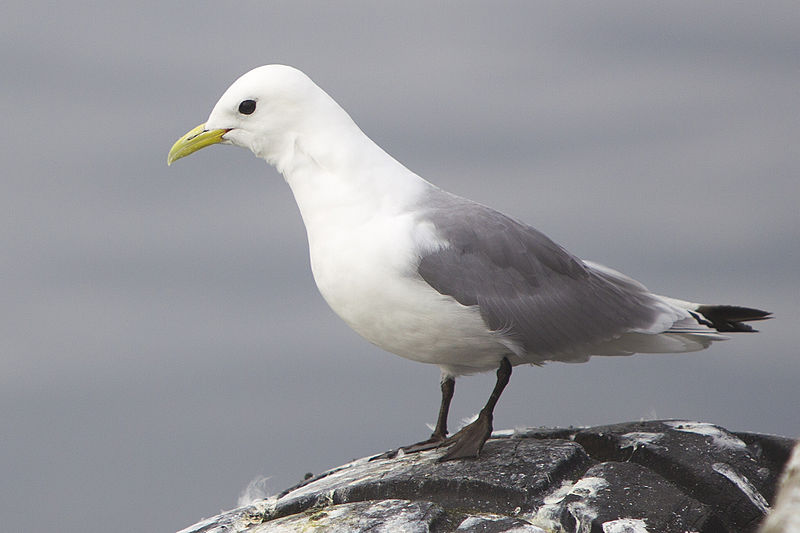
The Black-legged Kittiwake is a seabird of the gull family Laridae. It was first described by Carl Linnaeus in 1758, and its name derives from its distinctive call, which sounds like ‘kittee-wa-take, kitten-wa-make.’
These birds are mainly found along coastal regions with plenty of food sources such as plankton and fish. They have white bodies with slate-grey wings and black legs.
The bill is yellowish orange to red depending on age or season.
In winter, they migrate southwards away from their northern habitats into warmer waters for breeding purposes before returning again once spring arrives.
Scientific classification:
| Kingdom | Animalia |
| Phylum | Chordata |
| Class | Aves |
| Order | Charadriiformes |
| Family | Laridae |
| Genus | Rissa |
| Species | R. tridactyla |
Also Featured In: Common Cornwall Birds, Common Blue Birds of Georgia
10. Red Phalarope
The Red Phalarope (Phalaropus fulicarius) is a small wader native to the Arctic regions of North America and Eurasia.
During the breeding season, it will migrate across oceanic routes and winter at sea on tropical oceans – an unusual behavior for a wader species.
First described in 1750 by George Edwards, this bird has distinctive red plumage with black markings around its neck and wings.
Its bill is thin but sharp, which helps it catch its prey, such as insects or fish eggs, from the water’s surface.
As they are highly agile birds, they can be found spinning rapidly in shallow waters whilst searching for food using their long toes as paddles.
Scientific classification:
| Kingdom | Animalia |
| Phylum | Chordata |
| Class | Aves |
| Order | Charadriiformes |
| Family | Scolopacidae |
| Genus | Phalaropus |
| Species | P. fulicarius |
Also Featured In: Kyrgyzstan Birds, Tundra Birds
11. Glaucous Gull
The Glaucous Gull is a majestic bird species found in the Arctic regions of the Northern Hemisphere.
It has an impressive wingspan, one of the largest gulls and second only to The Great Black-Backed Gull.
During winter, they migrate southwards towards coasts along Holarctic shores, where their presence is as far down as South Africa.
Their genus name ‘Larus,’ from Latin origins, likely refers to some seabird. In contrast, its specific name, ‘hyperboreus,’ derives from Greek for “northern,” referencing Ancient Greeks who lived near what became known as the North Pole.
This stunning avian species makes them an unforgettable sight on any journey northward or through coastal areas throughout much of Europe and Asia.
Scientific classification:
| Kingdom | Animalia |
| Phylum | Chordata |
| Class | Aves |
| Order | Charadriiformes |
| Family | Laridae |
| Genus | Larus |
| Species | L. hyperboreus |
Also Featured In: Norway Birds, Large Birds of Michigan
12. Iceland Gull
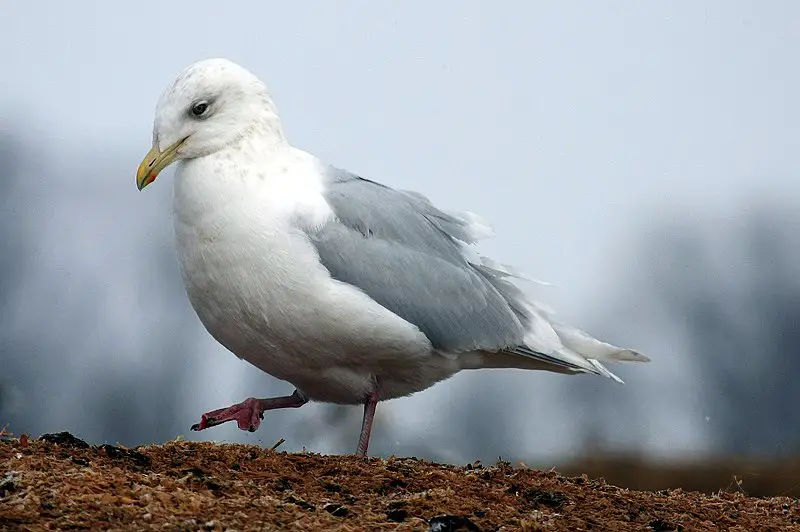
The Iceland Gull is a medium-sized, Arctic-dwelling gull whose range includes Canada and Greenland, but not its namesake.
Its gray wings are marked with black primaries and white tips on the inner secondary feathers, distinguishing it from other similar species like Larus hyperboreus, which has completely white secondary feathers.
It feeds mainly by scavenging or kleptoparasitism – stealing food from other birds – and actively pursuing smaller prey, such as crustaceans and insects in shallow waters near shorelines.
When breeding season arrives, they nest atop rocky outcrops found along coastal areas to provide adequate protection against predators while giving them an unobstructed view of their surroundings for when danger approaches.
The Iceland Gull can be seen during winter when visiting places like Iceland, where temperatures remain more hospitable than in its native habitat further north despite the cold weather.
Scientific classification:
| Kingdom | Animalia |
| Phylum | Chordata |
| Class | Aves |
| Order | Charadriiformes |
| Family | Laridae |
| Genus | Larus |
| Species | L. glaucoides |
Also Featured In: Iceland birds, Birds That Live around Gull Rock
13. Pink-Footed Goose
The Pink-footed Goose is a migratory bird that breeds in eastern Greenland, Iceland, and Svalbard.
It spends the winter in northwest Europe, such as Ireland, Great Britain, Netherlands, and western Denmark.
Its name comes from combining Latin for “goose” with ancient Greek words meaning ‘short beak.’
This species has pink legs and feet along with an orange bill. They have grey-brown upperparts and white underparts, making them easy to identify amongst other geese.
Their diet consists mainly of grasses, but they also eat grains like wheat or barley when available.
The population size of this species is increasing due to conservation efforts made by many countries across Europe dedicated to protecting these birds throughout their migration journey each year.
Scientific classification:
| Kingdom | Animalia |
| Phylum | Chordata |
| Class | Aves |
| Order | Anseriformes |
| Family | Anatidae |
| Genus | Anser |
| Species | A. brachyrhynchus |
Also Featured In: Most Common Birds of Netherlands Island, Jersey Island Birds You Should Know
14. Northern Fulmar
The Northern Fulmar is a seabird that resides in the subarctic regions of the North Atlantic and North Pacific oceans. It has one distinctive color morph: white head, body, and gray wings.
Due to its habitat preferences, this bird had been seen only once in the Southern Hemisphere, south of New Zealand.
Its diet includes fish eggs, crustaceans, small squid, and other marine animals, which they consume while flying over the water surface or when swimming on the sea’s top layer looking for food.
The Fulmar also scavenges carrion, especially during breeding, as their chicks need more nutrition than adult birds.
They are highly abundant species, so no conservation measures have been taken yet, but monitoring them helps us understand population dynamics better.
Scientific classification:
| Kingdom | Animalia |
| Phylum | Chordata |
| Class | Aves |
| Order | Procellariiformes |
| Family | Procellariidae |
| Genus | Fulmarus |
| Species | F. glacialis |
Also Featured In: Most Common Birds of Farallon Islands,
15. Snow Bunting
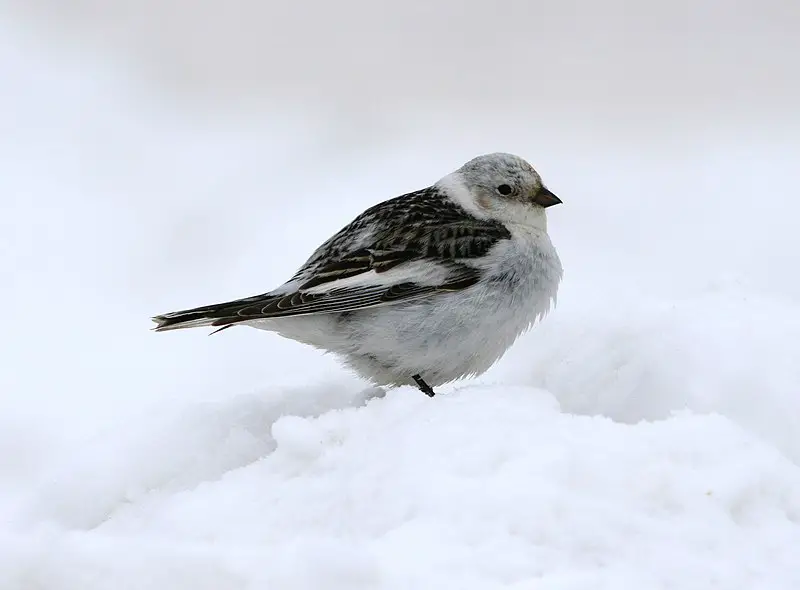
The snow bunting is a small and colorful passerine bird found in the Arctic regions of the northern hemisphere.
With its bright white feathers and black markings on its wings and tail, it stands out amongst other birds that inhabit these cold climates.
This species has adapted well to survive in this harsh environment; they nest under boulders or rocks, so their eggs are shielded from predators and blizzards.
They feed mainly on insects during summer but switch to seeds when winter arrives, seeking food sources that will not freeze over with ice.
The Snow bunting is an important part of the local ecosystem because it sustains larger animals, such as foxes and owls, who rely upon them for survival throughout the wintertime.
Scientific classification:
| Kingdom | Animalia |
| Phylum | Chordata |
| Class | Aves |
| Order | Passeriformes |
| Family | Calcariidae |
| Genus | Plectrophenax |
| Species | P. nivalis |
Also Featured In: Most Common Winter Birds, Flocks Birds around Us
16. Little Auk
The Little Auk, also known as the Dovekie or Alle alle, is a small but mighty bird. It has an unmistakable call that sounds like “all,” which is how it gets its name – taken from the Sami language of northern Scandinavia.
These birds are found in large flocks during winter months, where they migrate to far north polar regions to feed on fish, mollusks, and crustaceans.
They nest near coasts in rocky areas with low vegetation cover, making them difficult to spot in their natural habitat.
With numbers declining due to overfishing, we must protect this beautiful species so future generations can enjoy these little creatures, too.
Scientific classification:
| Kingdom | Animalia |
| Phylum | Chordata |
| Class | Aves |
| Order | Charadriiformes |
| Family | Alcidae |
| Genus | Alle Link, 1806 |
| Species | A. alle |
Also Featured In: Auks Species, Birds You’ll Find in the Sea
17. Thick-Billed Murre
The Thick-Billed Murre is a species of seabird in the Auk family. It is named after Danish zoologist Morten Thrane Brünnich, who was nicknamed Pallas’ murre by some.
These birds have black plumage with white underparts, a thick bill, and short wings, which makes them excellent swimmers but poor flyers.
They can often be seen perched on cliffs or floating together at sea, feeding mainly on fish and mollusks.
The Thick-Billed Murres nest in colonies along coastal areas, laying their eggs directly onto rocky terrain or ledges instead of nests like other bird species do.
This tough little bird has also been known to survive harsh arctic winters.
Scientific classification:
| Kingdom | Animalia |
| Phylum | Chordata |
| Class | Aves |
| Order | Charadriiformes |
| Family | Alcidae |
| Genus | Uria |
| Species | U. lomvia |
Also Featured In: Birds that Live in Newfoundland and Labrador, Birds that Live in Greenland
18. King Eider
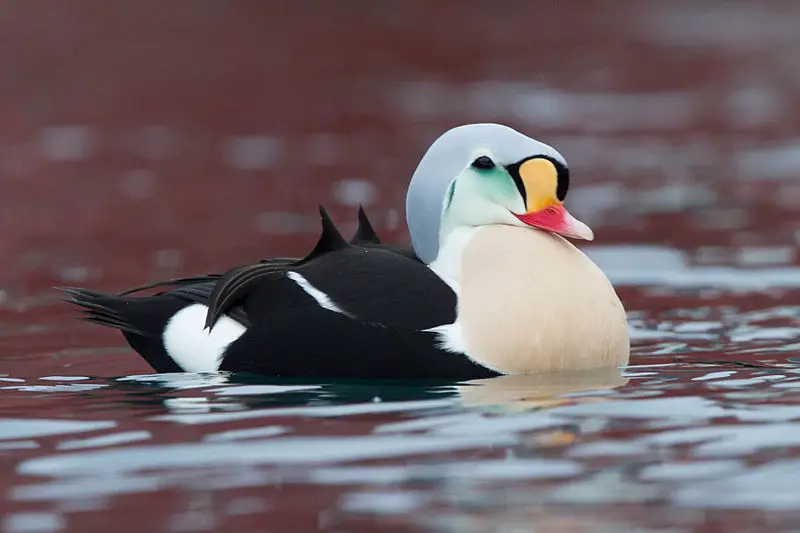
The King Eider is a large sea duck found in the Northern Hemisphere Arctic coasts of Northeast Europe, North America, and Asia.
It spends most of its year near coastal marine ecosystems at high latitudes before migrating to the tundra for the breeding season from June to July.
During this time, they lay four to seven eggs in grass-lined nests on the ground with downy feathers as additional insulation.
These beautiful birds are renowned for their attractive plumage, which consists of shades of white and black, often with bright orange or green patches around the head region.
They have wide wings that help them fly through long migrations yearly while protecting predators like foxes during nesting season.
The King Eider is an impressive species that has adapted well to life within its cold habitat over centuries.
Scientific classification:
| Kingdom | Animalia |
| Phylum | Chordata |
| Class | Aves |
| Order | Anseriformes |
| Family | Anatidae |
| Genus | Somateria |
| Species | S. spectabilis |
Also Featured In: Maine Birds, Birds that Live in Svalbard
19. Pectoral Sandpiper
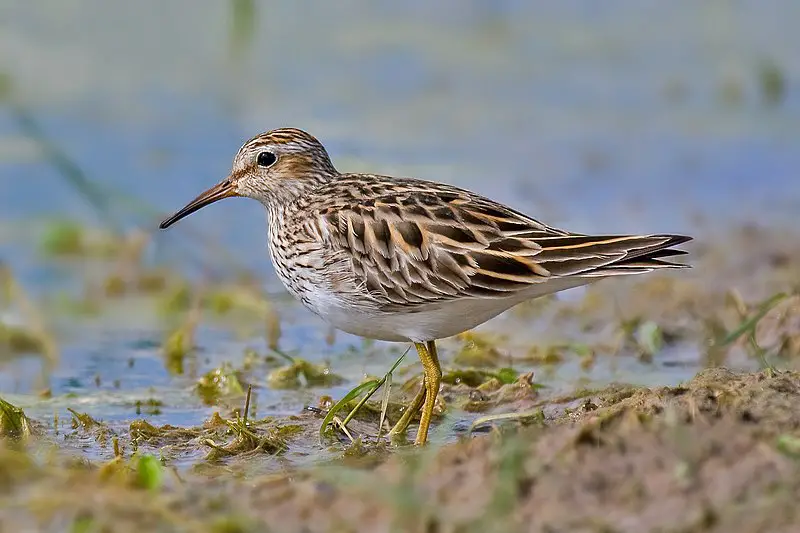
The pectoral sandpiper is a migratory wader found in North America and Asia but can be seen in South America and Oceania during the winter.
This small bird primarily feeds on small invertebrates. It creates a deep hole in the ground lined with thick materials to protect its four eggs from harsh weather conditions during breeding.
Measuring 21 cm (8.3 in) in length and with a wingspan of 46, the Pectoral sandpiper is a small bird that is easy to spot.
Scientific classification:
| Kingdom | Animalia |
| Phylum | Chordata |
| Class | Aves |
| Order | Charadriiformes |
| Family | Scolopacidae |
| Genus | Calidris |
| Species | C. melanotos |
Also Featured In: Birds of Norfolk, Most Common Birds of Sierra Islands
20. Pomarine Jaeger
The Pomarine jaeger is a migratory seabird that belongs to the skua family Stercorariidae. It spends winter at sea in tropical oceans.
Although its relationships are not entirely understood, its mitochondrial DNA is most similar to the great skua. At the same time, its behavior and morphology relate more to lesser skuas, such as the parasitic jaeger.
This bird’s distinctive features include a black cap and a thick, hooked bill that it uses to snatch fish from other seabirds.
It has a white belly and dark grey-brown plumage on its upper parts, making it easily recognizable as it reaps through the ocean in search of prey.
The Pomarine Jaeger is a fascinating bird that plays an important role in maintaining the ocean’s ecological balance.
Scientific classification:
| Kingdom | Animalia |
| Phylum | Chordata |
| Class | Aves |
| Order | Charadriiformes |
| Family | Stercorariidae |
| Genus | Stercorarius |
| Species | S. pomarinus |
Also Featured In: Martinique Island Birds You Should Know, Common Birds Found near Saint Helena
Conclusion
Spitsbergen, the largest island in the Svalbard archipelago, hosts various bird species during the brief Arctic summer.
From seabirds nesting on coastal cliffs to waterfowl inhabiting freshwater lakes and ponds and from tundra-dwelling species to those found along rocky shorelines, the avian inhabitants of Spitsbergen represent a remarkable adaptation to the extreme conditions of the Arctic.
Exploring the birdlife of Spitsbergen offers a glimpse into the resilience and beauty of nature in one of the Earth’s northernmost regions, highlighting the importance of preserving these fragile ecosystems for future generations to appreciate and study.